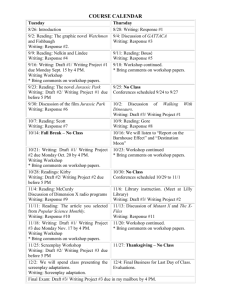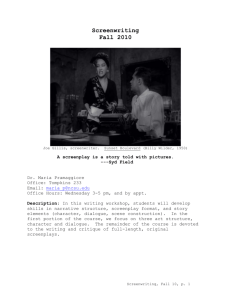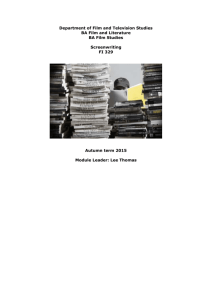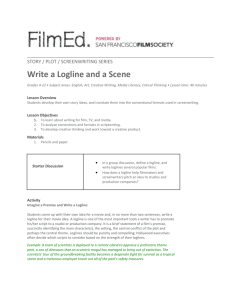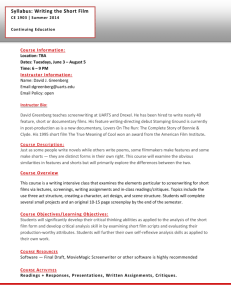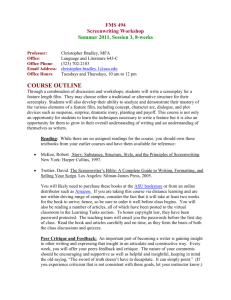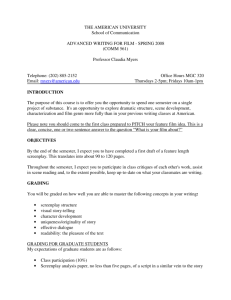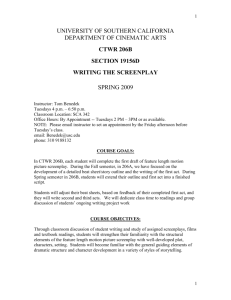Truby, J. (2008). The Anatomy of Story: 22 Steps to Becoming a
advertisement
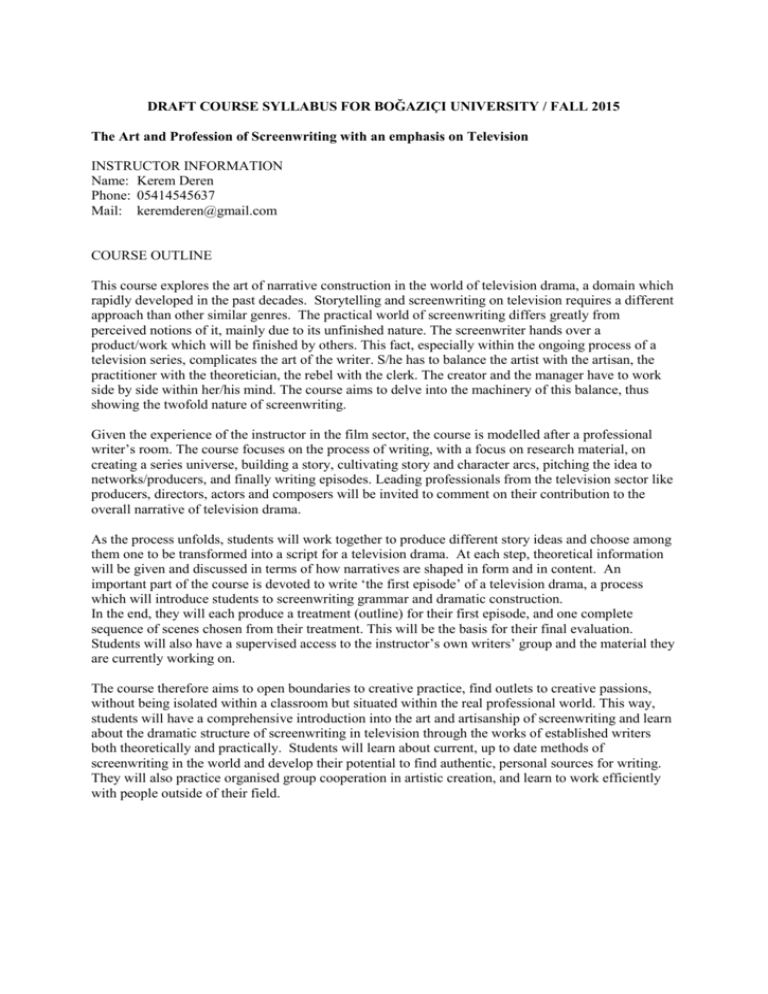
DRAFT COURSE SYLLABUS FOR BOĞAZIÇI UNIVERSITY / FALL 2015 The Art and Profession of Screenwriting with an emphasis on Television INSTRUCTOR INFORMATION Name: Kerem Deren Phone: 05414545637 Mail: keremderen@gmail.com COURSE OUTLINE This course explores the art of narrative construction in the world of television drama, a domain which rapidly developed in the past decades. Storytelling and screenwriting on television requires a different approach than other similar genres. The practical world of screenwriting differs greatly from perceived notions of it, mainly due to its unfinished nature. The screenwriter hands over a product/work which will be finished by others. This fact, especially within the ongoing process of a television series, complicates the art of the writer. S/he has to balance the artist with the artisan, the practitioner with the theoretician, the rebel with the clerk. The creator and the manager have to work side by side within her/his mind. The course aims to delve into the machinery of this balance, thus showing the twofold nature of screenwriting. Given the experience of the instructor in the film sector, the course is modelled after a professional writer’s room. The course focuses on the process of writing, with a focus on research material, on creating a series universe, building a story, cultivating story and character arcs, pitching the idea to networks/producers, and finally writing episodes. Leading professionals from the television sector like producers, directors, actors and composers will be invited to comment on their contribution to the overall narrative of television drama. As the process unfolds, students will work together to produce different story ideas and choose among them one to be transformed into a script for a television drama. At each step, theoretical information will be given and discussed in terms of how narratives are shaped in form and in content. An important part of the course is devoted to write ‘the first episode’ of a television drama, a process which will introduce students to screenwriting grammar and dramatic construction. In the end, they will each produce a treatment (outline) for their first episode, and one complete sequence of scenes chosen from their treatment. This will be the basis for their final evaluation. Students will also have a supervised access to the instructor’s own writers’ group and the material they are currently working on. The course therefore aims to open boundaries to creative practice, find outlets to creative passions, without being isolated within a classroom but situated within the real professional world. This way, students will have a comprehensive introduction into the art and artisanship of screenwriting and learn about the dramatic structure of screenwriting in television through the works of established writers both theoretically and practically. Students will learn about current, up to date methods of screenwriting in the world and develop their potential to find authentic, personal sources for writing. They will also practice organised group cooperation in artistic creation, and learn to work efficiently with people outside of their field. COURSE POLICIES Trust. Writing is a deeply personal affair. It is imperative that everyone in the class respects the private nature of creativity, and exercises respect in their criticism as well as due discretion outside the class. Everyone has to feel safe in sharing their work. Attendance. This is a compact course with a tightly knit process. Each step follows the other. Attendance is crucial in keeping up with the class work and will be part of my evaluation and the lack of it a basis for failure. Submission of work. Because of the practical nature of the course, almost every week will have a written exercise. We will share these exercises and facilitate group discussions on them. We will be shaping out model TV series based on these exercises. Timely submission is important to allow for everyone to read our work and comment on it in class. COURSE READINGS Required: Main textbooks Hunter, L. (2004). Lew Hunter's Screenwriting 434: The Industry's Top Teacher Reveals the Secrets of the Successful Screenplay by Lew Hunter, New York: The Berkley Publishing Group. Russin, U.R./ Downs, W.M. (2012). Screenplay: Writing the Picture, Los Angeles: Silman-James Pres. Vogler, C. (2007). Writer's Journey: Mythic Structure for Writers, California: Michael Wiese Productions Field, S. (2005). Screenplay: The Foundations of Screenwriting: A Step-by-Step Guide from Concept to finished Script. New York: Dell Publishing. McKee, R. (1997). Story: Style, Structure, Substance, and the Principles of Screenwriting. New York: Harper-Collins Publishers Truby, J. (2008). The Anatomy of Story: 22 Steps to Becoming a Master Storyteller. London: Faber&Faber Jung, C. G. (1990). Man and His Symbols. New York: Arcade Penguin Riley, C. (2009). The Hollywood Standard: The Complete and Authoritative Guide to Script Format and Style, California: Michael Weise production. Penniston P. (2010). Talk to Talk: A Dialogue Workshop for Screenwriters, California: Michael Wiese Productions Advised and for Reference: Walter, R. (2010). Essentials of Screenwriting: The Art, Craft, and Business of Film and Television Writing, USA: Plume. Bignell, J. (2013). An Introduction to Television Studies, London&New York: Routledge Key Guides. Mamet, D. (2000). Three Uses of the Knife: On the Nature and Purpose of Drama, New York: Vintage Books. Gulino, P. J. (2004). Screenwriting: The Sequence Approach. London, New Delhi, New York, Sydney: Bloomsbury. Kallas C. (2010). Creative Screenwriting: Understanding Emotinol Stracture, New York: Palgrave Macmillan. Campbell, J. (2008). The Hero with a Thousand Faces (The Collected Works of Joseph Campbell). California: New World Library. Lent, M. (2004). Breakfast with Sharks: A Screenwriter's Guide to Getting the Meeting, Nailing the Pitch, Signing the Deal, and Navigating the Murky Waters of Hollywood, New York: Three Rivers Press. Snyder, B. (2005). Save the Cat!: The Last Book on Screenwriting You'll Ever Need. California: Michael Wiese Productions. Hartley, J. (2011). Communication, Cultural and Media Studies: The Key Concepts, London & New York: Routledge Key Guides. Indick, W. (2004). Psychology for Screenwriters, California: Micheal Weise Production. Hilliard, R.J. (2011). Writing for Television, Radio, and New Media, Boston: Wadsworth/Thomason Publishing. Marks, D. (2006). Inside Story, California: Three Mountain Press. Suber, H. (2006).The Power of Film, California: Michael Weise Production. Aristotle (1997). Poetics, Penguin Classics Egri, L. (2009). Art Of Dramatic Writing: Its Basis in the Creative Interpretation of Human Motives, BN Publishing. Other: There will be several articles from TV and film journals. Specific movie and television series scripts will be read. COURSE PROGRAM Each session involves relevant reading assigned beforehand. Each session draws practical parallels to the actual TV sector, and the continuous analysis of current shows. In almost all sessions we will be watching relevant scenes/excerpts. In some sessions, there will be key speakers from the sector. Each session ends with an exercise and begins with the open discussion of the previous exercise. Week 1. What writing is not / its all about the ideas First we dissolve misconceptions about writing. Professional writing, in particular, is riddled with unrealistic myths. Writing is not just writing; it is observing, researching, structuring, discarding, and rewriting. Writing is layering from bottom up; from theme to idea to subject to story to outline to script. We will detail each step. Then we discuss the ideal atmosphere and rituals of the writer. In the second half of the class we will talk about ‘ideas.’ How ideas are found, chosen, processed. What makes an idea find its way to a finished script. Russin, U.R./ Downs, W.M. (2012). Screenplay: Writing the Picture, Los Angeles: Silman-James Pres. Chapter 1 pg. 1-15 Hunter, L. (2004). Lew Hunter's Screenwriting 434: The Industry's Top Teacher Reveals the Secrets of the Successful Screenplay by Lew Hunter, New York: The Berkley Publishing Group. Chapter 1 ‘Ideas’ pg. 17-34 advised: Walter, R. (2010). Essentials of Screenwriting: The Art, Craft, and Business of Film and Television Writing, USA: Plume. Chapter 2-3 pg. 8-33 Kallas C. (2010). Creative Screenwriting: Understanding Emotinol Stracture, New York: Palgrave Macmillan. Prologue 1-10 Week 2. Genres and themes: the beginning of stories What are the basic elements of a good series or a good film? We begin with examples from around the world and continue with those from Turkey. What are the most memorable characters, stories, scenes, and why? From an examination of successful elements, we arrive at themes that are close to our hearts. Now we begin crafting our own show. We study ‘themes.’ And come up with examples of our own. We discuss themes and try to find new ‘ideas’ around them. We pile, discuss, pull these ideas threads and discard. Learning and using basic principles, we arrive at our main idea. We develop this idea into a coherent TV series subject. And start constructing our ‘story.’ General outlines of stories, what they’re made of. Russin, U.R./ Downs, W.M. (2012). Screenplay: Writing the Picture, Los Angeles: Silman-James Pres. Chapter 3, pg. 37-44 Field, S. (2005). Screenplay: The Foundations of Screenwriting: A Step-by-Step Guide from Concept to finished Script. New York: Dell Publishing. Chapter 1 pg.1-14, Chapter 3 pg. 37-44 Week 3. Building a Story Elements of creating a story. Different approaches to building a story. The introduction of ‘methods’ in writing. Russin, U.R./ Downs, W.M. (2012). Screenplay: Writing the Picture, Los Angeles: Silman-James Pres. Chapter 3, pg. 45-59 Field, S. (2005). Screenplay: The Foundations of Screenwriting: A Step-by-Step Guide from Concept to finished Script. New York: Dell Publishing. Chapter 1 ‘What is a screenplay’ pg. 15-31 & Chapter 2 ‘The Subject’ pg. 31-43 Chapter 4 ‘The world of the story’ pg. 45-60 Truby, J. (2008). The Anatomy of Story: 22 Steps to Becoming a Master Storyteller. London: Faber&Faber. Chapter 1 ‘Story Space Story Time’ - Chapter 2 ‘Premise’ - Chapter 3 ‘The Seven Key Steps of Story Structure’ pg. 3-56 advised: Kallas C. (2010). Creative Screenwriting: Understanding Emotinol Stracture, New York: Palgrave Macmillan. Chapter ‘The Middle, Techniques of Creative Screenwriting’ pg. 75-151 Walter, R. (2010). Essentials of Screenwriting: The Art, Craft, and Business of Film and Television Writing, USA: Plume. Chapter 5 ‘Conflict Violence and Sex’ - Chapter 6 ‘Illusion Real vs. Reel’ – Chapter 7 ‘Story Tale Assembly’ pg. 47-84 Week 4. Character Everything about building characters as the main pillar of a story. Different approaches to character building. General overview of ‘character driven’ stories. Everything that’s been done so far serves to construct well rounded characters. Now ideas will become emotions, structure will become action though the characters we create. A leading actor from a TV show will visit our class and answer our questions. Truby, J. (2008). The Anatomy of Story: 22 Steps to Becoming a Master Storyteller. London: Faber&Faber. Chapter 4 ‘Character’ - Chapter 5 ‘Moral Argument’ pg. 56-145 Field, S. (2005). Screenplay: The Foundations of Screenwriting: A Step-by-Step Guide from Concept to finished Script. New York: Dell Publishing. Chapter 3 ‘The Creation of Character’ & Chapter 4 ‘Building a Character Russin, U.R./ Downs, W.M. (2012). Screenplay: Writing the Picture, Los Angeles: Silman-James Pres. Chapter 5 ‘Character’ pg. 60-90 Week 5. Dramatic Structure 1 Welcome to the math of screenwriting. First a quick historical approach to structure. Then, the main topics and rules of drama construction. The basic architecture of dramatic writing, stuff that enables us to transcribe what’s in our hearts into a comprehensible whole. The glue, the mortar of screenwriting. Plot points, sequences, acts, inciting incidents, conflict types, dramatic needs… All the rules and tricks of the trade. Russin, U.R./ Downs, W.M. (2012). Screenplay: Writing the Picture, Los Angeles: Silman-James Pres. Chapter 6.7 pg. 91-134 Aristotle (1997). Poetics, Penguin Classics Egri, L. (2009). Art Of Dramatic Writing: Its Basis in the Creative Interpretation of Human Motives, BN Publishing. Week 6. Dramatic Structure 2 An overview of all major instructors of the field: Truby, McKee, Field, Hunter and the like. Taking a quick look at all renowned structural theories, we try to understand the underlying principles. Then comes the exploration and analysis of films through their structure. We watch excerpts of a movie and a TV show and dissect it. Russin, U.R./ Downs, W.M. (2012). Screenplay: Writing the Picture, Los Angeles: Silman-James Pres. Chapter 8, 9, 10, 11 pg. 135-234 General reading: Gulino, P. J. (2004). Screenwriting: The Sequence Approach. London, New Delhi, New York, Sydney: Bloomsbury. Field, S. (2005). Screenplay: The Foundations of Screenwriting: A Step-by-Step Guide from Concept to finished Script. New York: Dell Publishing. McKee, R. (1997). Story: Style, Structure, Substance, and the Principles of Screenwriting. New York: Harper-Collins Publishers. Truby, J. (2008). The Anatomy of Story: 22 Steps to Becoming a Master Storyteller. London: Faber&Faber. Week 7. Hero’s Journey We analyse Christopher Vogler’s Hero’s Journey and apply it to our own show. Vogler, C. (2007). Writer's Journey: Mythic Structure for Writers, California: Michael Wiese Productions. Campbell, J. (2008). The Hero with a Thousand Faces (The Collected Works of Joseph Campbell), California: New World Library. Jung, C. G. (1990). Man and His Symbols, New York: Arcade Penguin. pg. 1-95 “Ancient Myths and Modern Man” by Joseph L. Henderson pg. 95-157 “Symbolism in the Visual Arts” by Aniela Jaffe pg. 255-323 Week 8. Writing a screenplay 1 The format. The general grammar of screenwriting. The connection between script format and screenwriting; how and why the format makes life easier. How to understand format in a creative way. Riley, C. (2009). The Hollywood Standard: The Complete and Authoritative Guide to Script Format and Style, California: Michael Weise production. General Reading Field, S. (2005). Screenplay: The Foundations of Screenwriting: A Step-by-Step Guide from Concept to finished Script. New York: Dell Publishing. Chapter 13 ‘Screenplay Form’ pg. 215-238 Hunter, L. (2004). Lew Hunter's Screenwriting 434: The Industry's Top Teacher Reveals the Secrets of the Successful Screenplay by Lew Hunter, New York: The Berkley Publishing Group. Chapter 4, pg. 87-117 Computer Software: Finaldraft Week 9. Writing a Screenplay 2 How do you prepare for a scene; what is the work necessary before sitting down to write a scene. The basic elements of a scene. The basic tools of writing a scene. The necessary points you have to cover. Examples of good scenes, and their analysis. Russin, U.R./ Downs, W.M. (2012). Screenplay: Writing the Picture, Los Angeles: Silman-James Pres. Chapter 12,13 pg. 235-291 Hunter, L. (2004). Lew Hunter's Screenwriting 434: The Industry's Top Teacher Reveals the Secrets of the Successful Screenplay by Lew Hunter, New York: The Berkley Publishing Group. Chapter 5 pg. 119-159 Week 10. Writing a screenplay 3 We work further on the elements of a scene. From dialogue to action, we study approaches to each of these elements. We work on perspectives, twists, endings, and the connection of themes to finished scenes. We dissect our scene from every angle and work on possible alternatives to each scene. Our final exercise begins at the end of this session. Students will write a full sequence of scenes. Hunter, L. (2004). Lew Hunter's Screenwriting 434: The Industry's Top Teacher Reveals the Secrets of the Successful Screenplay by Lew Hunter, New York: The Berkley Publishing Group. Chapter 6.7 pg. 161-311 Field, S. (2005). Screenplay: The Foundations of Screenwriting: A Step-by-Step Guide from Concept to finished Script. New York: Dell Publishing. Chapter 6 ‘Endings and Beginnings’ Chapter 7 ‘Setting up the Story’ - Chapter 8 ‘Two Incidents’ - Chapter 9 ‘Plot Points’ - Chapter 10 ‘The Scene’ - Chapter 11 ‘The Sequence’ - Chapter 12 ‘Building the Storyline’, pg. 89-215 Penniston P. (2010). Talk to Talk: A Dialogue Workshop for Screenwriters, California: Michael Wiese Productions. General browsing. Week 11. The Furnace: An actual Set A field trip to an actual TV set in progress. Conversations with professionals. A general overview of the relationship between the writer and the production team. Lent, M. (2004). Breakfast with Sharks: A Screenwriter's Guide to Getting the Meeting, Nailing the Pitch, Signing the Deal, and Navigating the Murky Waters of Hollywood, New York: Three Rivers Press. General reading Russin, U.R./ Downs, W.M. (2012). Screenplay: Writing the Picture, Los Angeles: Silman-James Pres. Part IV ‘Marketing’, Part V ‘Alternatives’ pg. 303-391 Walter, R. (2010). Essentials of Screenwriting: The Art, Craft, and Business of Film and Television Writing, USA: Plume. Part III ‘Business’ 263-327 Week 12. Assessment and rewrite The final exercises are assessed and discussed. The final lesson is the ‘rewrite.’ We talk about rewriting principles, and give out rewriting/revision notes. Russin, U.R./ Downs, W.M. (2012). Screenplay: Writing the Picture, Los Angeles: Silman-James Pres. Chapter 14 pg. 291-302 Hunter, L. (2004). Lew Hunter's Screenwriting 434: The Industry's Top Teacher Reveals the Secrets of the Successful Screenplay by Lew Hunter, New York: The Berkley Publishing Group. Chapter 8 ‘The Rewrites’ pg. 313-343 Week 13. Overview First, we see what happens to our script after we write it. Learning about the other actors of the film making process, we fully grasp the crucial interactions. From idea to scene, we have closed the circle of a screenwriter’s basic process. Then we reflect on this whole creative work. What it means to us. How much of how we feel, what we want to express has actually found its way onto the screen. Have we bridged the gap between inspiration and hard work, between instinct and math. How far have gone in understanding and harmonizing our art and our craft? And most importantly. How good are the upcoming ratings? Bignell, J. (2013). An Introduction to Television Studies, London&New York: Routledge Key Guides. Chapter 9 ‘Television You Can’t See’ - Chapter 10 ‘Television Audiences’ pg. 231-279 Mamet, D. (2000). Three Uses of the Knife: On the Nature and Purpose of Drama, New York: Vintage Books. Lent, M. (2004). Breakfast with Sharks: A Screenwriter's Guide to Getting the Meeting, Nailing the Pitch, Signing the Deal, and Navigating the Murky Waters of Hollywood, New York: Three Rivers Press. pg. TBA Hunter, L. (2004). Lew Hunter's Screenwriting 434: The Industry's Top Teacher Reveals the Secrets of the Successful Screenplay by Lew Hunter, New York: The Berkley Publishing Group. Chapter 5, ‘The Act one Script’ - Chapter 6 ‘The Act two Script’ - Chapter 7 ‘The Act three Script’ pg. 119-311
